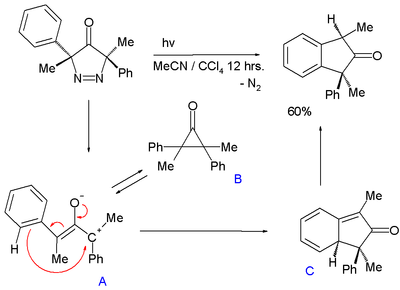- Cyclopropanone
-
Cyclopropanone  cyclopropanone
cyclopropanoneIdentifiers CAS number 5009-27-8 PubChem 138404 ChemSpider 122027 
Jmol-3D images Image 1
Image 2- C1CC1=O
O=C1CC1
Properties Molecular formula C3H4O Molar mass 56.06326 Density 0.867 g/mL at 25 °C Melting point −90 °C
Boiling point 50-53 °C at 22 mmHg
 (verify) (what is:
(verify) (what is:  /
/ ?)
?)
Except where noted otherwise, data are given for materials in their standard state (at 25 °C, 100 kPa)Infobox references Cyclopropanone is an organic compound with molecular formula C3H4O consisting of a cyclopropane carbon framework with a ketone functional group. The parent compound is labile with melting point −90 °C and has been prepared by reaction of ketene with diazomethane at −145 °C.[1][2] Derivatives of cyclopropanone are of some interest to organic chemistry.[3]
In organic synthesis the use of cyclopropanone itself is substituted by that of synthons like acetals cyclopropanone ethyl hemiacetal[4] or cyclopropanone ethyl trimethylsilyl acetal.[5]
Derivatives
Cyclopropanones are intermediates in the Favorskii rearrangement with cyclic ketones where carboxylic acid formation is accompanied by ring-contraction.
An interesting feature of cyclopropanones is that they react as 1,3-dipoles in cycloadditions for instance with cyclic dienes such as furan.[6][7] An oxyallyl intermediate or valence tautomer (formed by cleavage of the C2-C3 bond) is suggested as the active intermediate or even a biradical structure (compare to the related trimethylenemethane).
Experimental evidence is not conclusive. Other reactions of cyclopropanones take place through this intermediate. For instance enantiopure (+)-trans-2,3-di-tert-butylcyclopropanone racemizes when heated to 80 °C.[8]
An oxyallyl intermediate is also proposed in the photochemical conversion of a 3,5-dihydro-4H-pyrazole-4-one with expulsion of nitrogen to an indane:[9]
In this reaction oxyallyl intermediate A, in chemical equilibrium with cyclopropanone B attacks the phenyl ring through its carbocation forming a transient cyclohexadiene[disambiguation needed
 ] C (with UV trace similar to isotoluene) followed by rearomatization. The energy difference between A and B is 5 to 7 kcal/mol (21 to 29 kJ/mol).
] C (with UV trace similar to isotoluene) followed by rearomatization. The energy difference between A and B is 5 to 7 kcal/mol (21 to 29 kJ/mol).See also
- Other cyclic ketones: cyclobutanone, cyclopentanone, cyclohexanone
- Other cyclopropane derivatives: cyclopropene, cyclopropenone
References
- ^ Preparation and characterization of cyclopropanone, methylcyclopropanone, 2,2-dimethylcyclopropanone and tetramethylcyclopropanone N. J. Turro and W. B. Hammond, Tetrahedron, Volume 24, Issue 18, 1968, Pages 6017-6028 doi:10.1016/S0040-4020(01)90985-8
- ^ Cryochemical synthesis and molecular energetics of cyclopropanone and some related compounds E. F. Rothgery, R. J. Holt, H. A. McGee, , Jr. J. Am. Chem. Soc.; 1975; 97(17); 4971-4973. doi:10.1021/ja00850a034
- ^ Cyclopropanones Nicholas J. Turro, Acc. Chem. Res.; 1969; 2(1); 25-32. doi:10.1021/ar50013a004
- ^ Organic Syntheses, Coll. Vol. 7, p.131 (1990); Vol. 63, p.147 (1985). [Link http://www.orgsynth.org/orgsyn/pdfs/CV7P0131.pdf]
- ^ Datasheet commercial supplier Link
- ^ Cyclopropanones. XII. Cycloaddition reactions of cyclopropanones Nicholas J. Turro, Simon S. Edelson, John R. Williams, Thomas R. Darling, Willis B. Hammond, J. Am. Chem. Soc.; 1969; 91(9); 2283-2292. doi:10.1021/ja01037a018
- ^ Cyclopropanones. XVII. Kinetics of the cycloaddition reaction of cyclopropanones with 1,3-dienes Simon S. Edelson, Nicholas J. Turro J. Am. Chem. Soc.; 1970; 92(9); 2770-2773. doi:10.1021/ja00712a030
- ^ Thermal reactions of a cyclopropanone. Racemization and decarbonylation of trans-2,3-di-tert-butylcyclopropanone Frederick D. Greene, David B. Sclove, Jose F. Pazos, Ronald L. Camp J. Am. Chem. Soc.; 1970; 92(25); 7488-7488. doi:10.1021/ja00728a051
- ^ First Direct Detection of 2,3-Dimethyl-2,3-diphenylcyclopropanone Andrey G. Moiseev, Manabu Abe, Evgeny O. Danilov, and Douglas C. Neckers, J. Org. Chem.; 2007; 72(8) pp 2777 - 2784; (Article) doi:10.1021/jo062259r
Categories:- Ketones
- Cyclopropanes
- C1CC1=O
Wikimedia Foundation. 2010.


